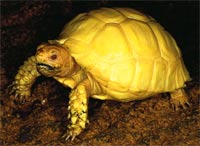Are my sulcata tortoises albino?
Q. I hatched my first baby sulcata tortoises (African spurred tortoises, Geochelone sulcata) recently, and among them were two surprises. Two are much lighter in color than the others (there were 12 total) but normal in size and every other way. Could they be albino sulcata tortoises? Their eyes have some pink, but only when I turn them into the light at a certain angle. If they are albino sulcata tortoises, are they the first ones in captivity? I haven’t decided yet if I’ll keep them. If I do, is there any special advice you’d offer besides keeping them in the shade?
Jennifer Johns
California

Photograph by Bill Love
This juvenile amelanistic African spurred tortoise (Geochelone sulcata) is considerably paler than even a light-colored normal example of the species.
A. They might be amelanistic (albino) sulcata tortoises. If you take a clear photo of one or both and send it to REPTILES magazine, I could probably judge since I’ve already seen a few of them years ago. Unfortunately for you, that alone means yours are not the first ones around.
If anyone reading is wondering how someone could confuse an amelanistic reptile with a normal reptile, they may not be familiar with sulcata tortoises. Normal sulcata tortoise specimens are pale tan or straw-colored, so eliminating the remaining melanin (black pigment) doesn’t result in radical difference like it would in most other species sporting more black.
Amelanism in reptiles is a recessively inherited trait in all the species I’ve ever heard of it occurring in. That means it will show up in one-fourth of the offspring produced from pairings of normal-looking but gene-carrying (heterozygous) parents. Why is that significant?
Thousands of captive-born sulcata tortoises have been produced from imports over the past 15 or so years. Shortly after the most recent wave of imported adult sulcate tortoises arrived during the early 1990s, captive breeding ensued. With as little as five years needed to reach reproductive maturity, at least three generations have already been produced by some U.S. breeders.
Many of those first captive-bred baby sulcata tortoises went to other breeders, often as groups including siblings. The albino gene must have cropped up early, and when siblings ended up mating, it was reunited more rapidly than might have occurred in the wild. Before the trait was widely recognized, amelanistic hets (gene carriers) were sold and spread around. Your breeding stock may have come from such a situation.
Richard Fife of Riparian Farms in Arizona hatched the first Ivory Tortoise sulcata about six years ago. It appears to be a form of amelanism, resulting in an ivory-white tortoise with pinkish eyes (depending on how the light hits them). Richard told me he probably let out specimens het for the trait unknowingly during his early years of breeding them. Your adults may be related to his line, or they may be something different and new.
The main thing you can almost certainly count on is that your adult sulcata tortoises are heterozygous for the trait. The odds say that one-fourth of any clutch they produce should exhibit the pale trait you’ve got. A ratio of two out of 12 in your current clutch is close enough statistically to one-fourth to bear that out.
If it is amelanism you’ve got, the only consideration I’d suggest is the one you’re already aware of: provide a pen with plenty of shaded portions not in direct sunlight all the time. Some amelanistic reptiles have eyes that are more sensitive to bright light because they don’t have the normal pigments to help shield them. Sulcata tortoises are diurnally active, so shade would offer them some relief if they showed unusual sensitivity on bright days.



